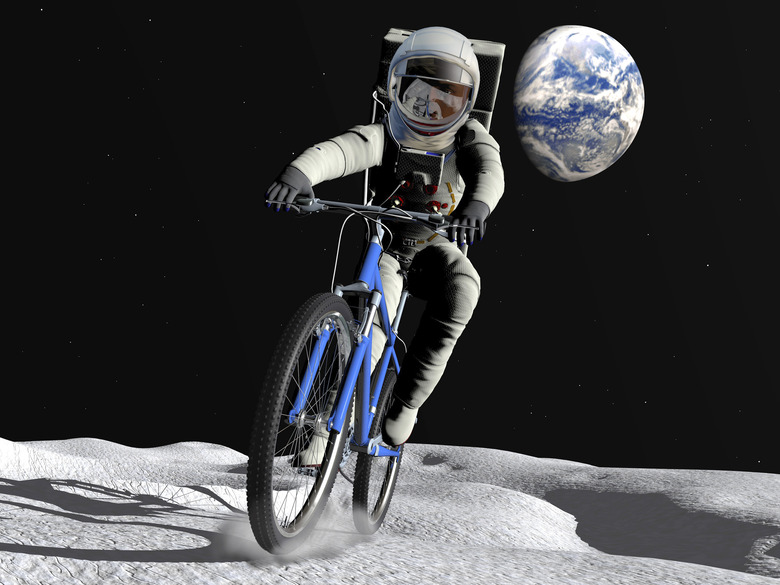Science Project On Gravity And Motion For Third Graders
Sir Isaac Newton is credited with the discovery of gravity when in 1687 he published a book about his findings. He saw an apple fall from a tree and named that force gravity. He created three laws to further define this phenomenon. The first law of inertia says that any object in motion or at rest will stay that way until another object or force acts to change it. The second law defines acceleration as a change in velocity when a force acts on an object. The third law says that every action has an equal and opposite reaction.
Inclined Plane
Inclined Plane
Make an inclined plane with paper towel tubes, pieces of wood or cardboard boxes. Try different heights such as 1 to 4 feet from the ground using books, chairs or boxes. Have a container or box at the end of your incline to catch the test objects. Use small objects like marbles, balls or hot wheels. Note the time it takes for each object to move from the top to the bottom of the incline using a timer or stopwatch. Third graders will find that it takes longer for objects to travel down the less steep inclined planes while objects move faster down steeper inclines. This demonstrates Newton's second law since objects accelerate to the ground faster when the incline is more vertical or steep.
Balloon Rocket Race
Balloon Rocket Race
Set two chairs at least 10 feet apart. Put a straw on a piece of kite string and tie it to the chairs. Do this for another set of chairs next to the first set. Use a balloon pump to blow up a balloon. Do not tie it closed, but hold it so the air doesn't escape. Use tape to attach the balloon to the straw. Start the balloon at the chair where the open end is facing that chair. Two students can race their balloons to see which one goes further. Try different shapes and sizes of balloons to see if the results are different. This project demonstrates Newton's third law because as the air rushes backward out of the balloon it pushes the straw along the string in the opposite direction with an equal force.
Friction Fun
Friction Fun
Friction is the force seen when objects rub together. Friction causes objects to move slower or not at all. Tape a ruler to the wall so that the "0 inches" end is at the bottom and "12 inches" is at the top. Use the smooth side of another ruler for this project, along with a small wood block, a piece of construction paper, sandpaper, aluminum foil and waxed paper. Hold the ruler at the 3-inch mark on one end and rest the other end on the floor to make an incline. Place your wood block at the top of the ruler and slowly move the ruler higher until the block moves. Record the height at which the block moves. Wrap the wood block with the different types of paper and foil and repeat the experiment. Third graders will find that wrapping the block usually causes friction and the ruler has to be inclined higher before the block will move. This project demonstrates Newton's first law since friction is the force that prevents the block from moving along the ruler. Students learn that the smooth papers produce less friction and the block will move along the ruler at lower levels, but the rough papers cause more friction.
Marshmallow Launch Device
Marshmallow Launch Device
For this project you'll need to cut out the bottom of a paper or plastic cup. Also cut a small slit in the top of a balloon and stretch it over the bottom of the cup so the inflation stem hangs out. Secure the balloon over the cup with tape to keep the balloon from falling off when it is pulled. Put a small marshmallow in the cup and pull the hanging inflation stem of the balloon to launch them across the room. Students will find that using different amounts of force to pull the balloon will launch the marshmallows different distances. This demonstrates all of Newton's laws. The marshmallow doesn't move until the force of pulling the balloon causes it to launch from the cup. The force of pulling the balloon back causes the marshmallow to accelerate out of the cup at a different speed and direction every time. Finally, the force of the marshmallow exiting the cup is the equal and opposite reaction observed from pulling the balloon.
Cite This Article
MLA
Wall, Nigel. "Science Project On Gravity And Motion For Third Graders" sciencing.com, https://www.sciencing.com/science-gravity-motion-third-graders-6868027/. 24 April 2017.
APA
Wall, Nigel. (2017, April 24). Science Project On Gravity And Motion For Third Graders. sciencing.com. Retrieved from https://www.sciencing.com/science-gravity-motion-third-graders-6868027/
Chicago
Wall, Nigel. Science Project On Gravity And Motion For Third Graders last modified August 30, 2022. https://www.sciencing.com/science-gravity-motion-third-graders-6868027/
